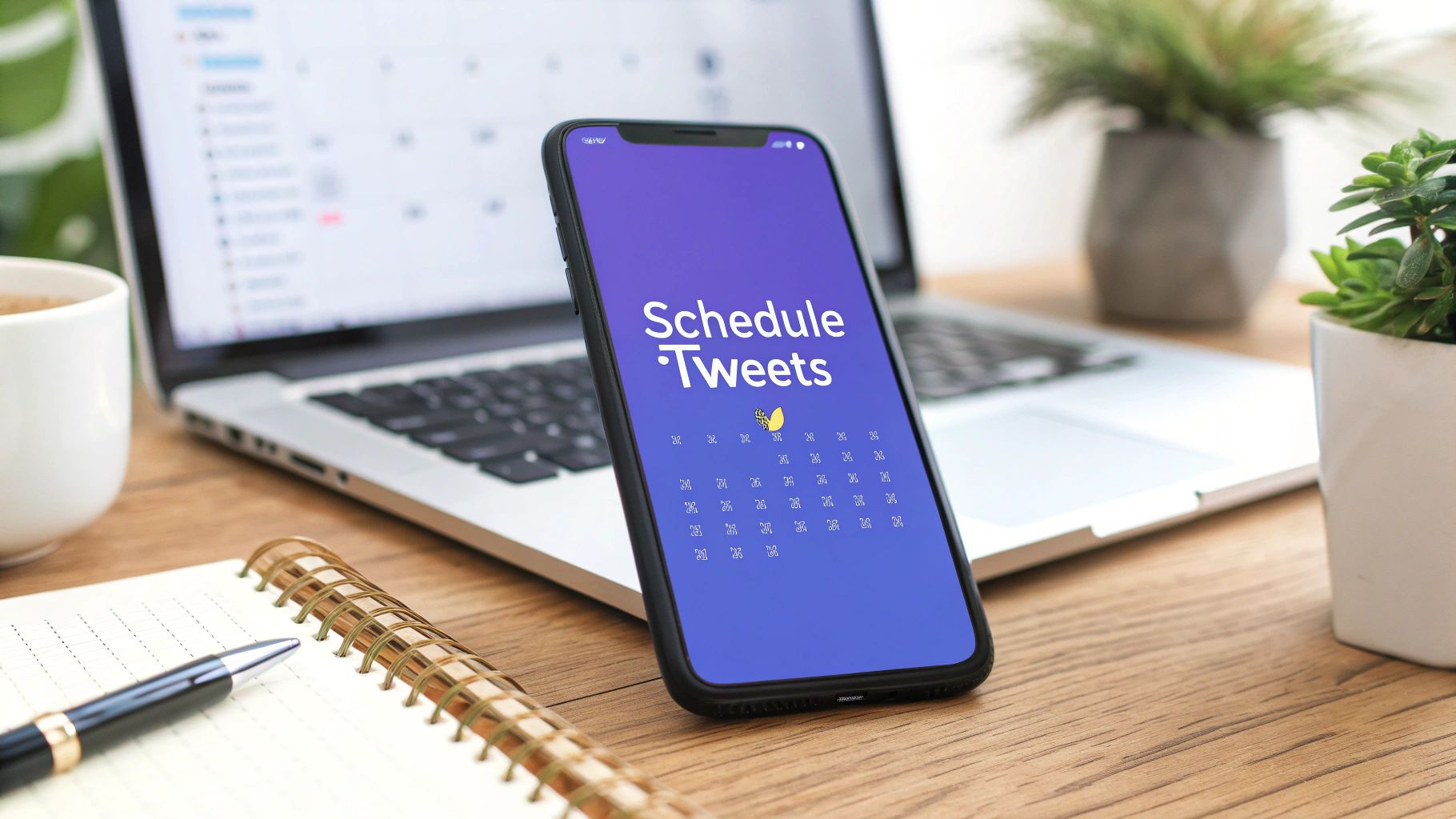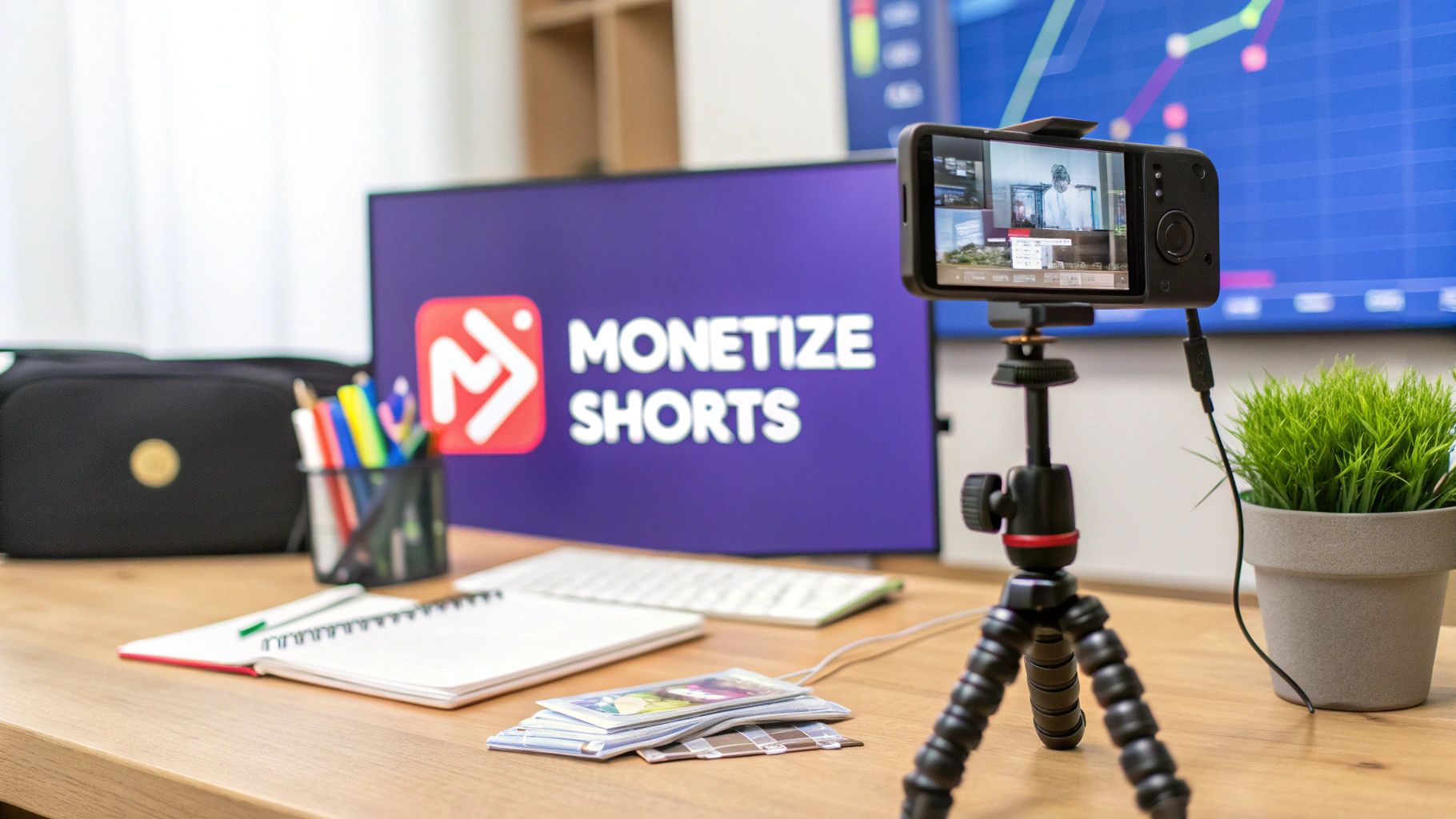Of course you can schedule tweets. Honestly, if you're serious about growing on X, it's less of a "can you" and more of a "you absolutely should."
Instead of scrambling to post something in the moment, you can map out your content ahead of time. This simple shift ensures you stay active and hit your audience right when they're scrolling, even if you’re nowhere near your phone. It's a total game-changer.
Why Scheduling Tweets Is No Longer Optional
On a platform that moves as fast as X, consistency is everything. When you schedule your content, you move from a reactive, "what do I post now?" mindset to a proactive, strategic one. You're in the driver's seat of your brand's story.
It’s all about working smarter. This frees you up from the content creation hamster wheel so you can focus on what really builds a community: jumping into conversations, replying to comments, and engaging in real-time.
The benefits are just too good to pass up:
- Stay Consistently Active: Your feed stays fresh and engaging, even when you’re on vacation or swamped with other work.
- Reach a Global Audience: Got followers in different time zones? Schedule posts to go live while they're having their morning coffee.
- Boost Your Content Quality: When you batch-create your posts, you have the space to be more thoughtful and strategic. No more rushed, last-minute tweets.
- Get Your Time Back: Block off a couple of hours and knock out a whole week's (or month's!) worth of content in one go.
Choosing the Right Scheduling Method
You've got two main options here: stick with X's built-in scheduler or upgrade to a more powerful third-party tool.
The native scheduler is fine for a one-off post here and there. But if you're building a real content strategy, you'll hit its limits fast. Tools like the PostSyncer Twitter scheduler are built for this, offering things like a visual content calendar, bulk scheduling, and analytics that the basic tool just can't touch.
For instance, the PostSyncer dashboard gives you a bird's-eye view of your entire content plan, even across multiple accounts.

This kind of visual layout makes it incredibly easy to spot gaps in your schedule and make sure you have a good mix of content going out.
With around 500 million tweets flying out every single day, your timing and organization are crucial for getting noticed. A good tool makes managing this chaos feel effortless, turning your X account into a well-oiled machine that works for you.
Your Tweet Scheduling Options At a Glance
Feeling a bit overwhelmed by the choices? It's simpler than it looks. Most people fall into one of a few camps depending on their needs. I've put together a quick comparison to help you figure out where you fit.
| Platform | Key Features | Pricing | Best For |
|---|---|---|---|
| Native X/Twitter | Basic post scheduling, media uploads, polls. | Free | Individuals posting occasionally or just getting started with scheduling. |
| PostSyncer | Visual calendar, bulk scheduling, content recycling, multi-account management. | Starts at $5/month | Solopreneurs, marketers, and creators who need an efficient, affordable, and powerful workflow. |
| Buffer | Clean UI, basic analytics, queuing system, landing page builder. | Free tier; paid plans start at $6/month per channel. | Small businesses and individuals who value simplicity and a straightforward user experience. |
| Hootsuite | All-in-one platform, advanced analytics, team collaboration, social listening. | Starts around $99/month | Large teams and agencies managing multiple clients and complex social strategies. |
Ultimately, the native tool is a starting point. But once you're ready to get serious about consistency and save a significant amount of time, a dedicated platform like PostSyncer, Buffer, or Hootsuite becomes essential. Your choice just depends on your budget and how many advanced features you truly need.
Getting Started With PostSyncer
Diving into a fresh scheduling tool shouldn’t feel like a chore. With PostSyncer, you can move from sign-up to your first scheduled tweet in under 5 minutes, so you focus on crafting messages—not wrestling with settings.
Creating an account is delightfully simple:
- Enter your name, email, and password
- Confirm your email address
- Jump straight into the dashboard (no credit card required)

The dashboard’s clean design guides you seamlessly toward connecting your Twitter profile. There’s zero clutter—just clear prompts to get you up and running.
Connecting Your Twitter Account
Hit the Connect a Social Profile button and follow the secure Twitter authorization flow. You’ll grant PostSyncer permission to post on your behalf without ever sharing your password.
- Authorization is handled through Twitter’s official API
- Accounts appear in your dashboard instantly
- Add multiple profiles for different clients or brands
Key Takeaway: Invite collaborators right away. Under Team Members, assign roles so your designer can draft posts without hitting publish.
Once your Twitter handle is live on PostSyncer, you’ve laid the groundwork. The next move? Craft and schedule your tweet.
Scheduling Your First Tweet
Click Compose, write your message, and pick a future date and time. Here’s how to make the most of it:
- Experiment with posting times based on your audience’s activity
- Use the calendar view to avoid content clashes
- Save drafts for batch edits and approval cycles
With these pointers, you’re scheduling like a seasoned pro—ready to maintain a steady, engaging presence on Twitter.
Building Your Content Calendar and Campaigns
Just throwing tweets out there whenever you have a spare moment? That’s not a strategy, and it rarely gets you anywhere. If you really want to make an impact, you need to stop thinking in terms of one-off posts and start building a proper content calendar. This is what turns a bunch of random ideas into a powerful, organized roadmap for growing your audience.
Inside PostSyncer, the content calendar is your command center. It's not just some boring list of scheduled times; it's a completely visual way to see your entire strategy laid out in front of you. This is how you start seeing the bigger picture.
Organize Your Strategy Visually
Let's get practical. The first thing you'll want to do is create distinct campaigns. A tech company, for instance, might set up campaigns for a big product launch, another for its weekly tech tips, and a third just for showing off its company culture.
This is where PostSyncer’s color-coding comes in handy. You can assign a color to each campaign and instantly see the balance of your content for the week or month.
- Blue: Product Launch Updates
- Green: Educational "How-To" Tweets
- Orange: Behind-the-Scenes Company Culture
This kind of visual clarity makes it painfully obvious when you have gaps. Are you pushing too much promotional stuff and not enough helpful content? The calendar will tell you at a glance, letting you fix it on the fly. To get started without staring at a blank page, you can always explore different content calendar templates to find a structure that works for you.
Here's a look at how a week's worth of content can be mapped out in PostSyncer, making sure you've got a healthy mix of topics and formats.

The best part? It's all drag-and-drop. If a trending topic suddenly blows up and you need to pivot, you can just grab that Tuesday post and slide it over to Thursday. No fuss.
Automation is about more than just convenience; it's about building a smarter marketing strategy. Properly scheduled tweets create a consistent stream of content that keeps your brand top-of-mind and your audience engaged.
For true efficiency, you have to get familiar with the bulk scheduling feature. This is an absolute game-changer. You can plan out dozens—even hundreds—of tweets in a simple CSV file, assign them to your different campaigns, and upload the whole thing in seconds. It literally turns the task of planning a month's worth of content into something you can knock out in a single afternoon. Your strategic calendar becomes a fully automated content machine.
Comparing Advanced Scheduling Features
While we're talking about planning, it's worth noting that not all schedulers are built the same. The more advanced your strategy becomes, the more you'll rely on specific features to execute it.
Here’s a quick breakdown of how PostSyncer stacks up against other popular tools when it comes to sophisticated content planning and automation.
| Feature | PostSyncer | Buffer | Hootsuite | TweetDeck |
|---|---|---|---|---|
| Content Categories/Campaigns | Yes (with color-coding) | Limited (tags only) | Yes (campaign planning) | No |
| Visual Calendar View | Yes (drag-and-drop) | Yes | Yes (planner view) | No |
| Bulk Scheduling (CSV) | Yes | Yes (with paid plans) | Yes | No |
| Evergreen Content Recycling | Yes (dedicated feature) | Yes (with paid plans) | Limited | No |
| AI Content Generation | Yes (integrated) | Yes (integrated) | Yes (OwlyWriter AI) | No |
As you can see, tools like PostSyncer are designed with campaign-based planning at their core, while simpler tools like TweetDeck are more for real-time management. Choosing the right one really depends on how deep you want to go with your content strategy.
Finding the Best Times to Post Your Tweets
Figuring out when your audience is actually online and listening is half the battle on Twitter. It's a classic problem—you can write the most brilliant, engaging tweet, but if you send it into the digital void at 3 AM, it's not going to make a dent.
The whole point is to post when your followers are actively scrolling and ready to jump into the conversation.
Of course, broad industry studies give you a decent starting point. For instance, one analysis of over a million tweets found that posting around 9 AM on Wednesdays consistently pulled in the highest engagement. That's a great clue, but your own data is where the real gold is.
This is where scheduling becomes more than just automation; it becomes a strategy.
Digging Into Your Analytics to Find Your Peak Times
It's time to move beyond generic advice and create a schedule that’s tailored to your audience. The best place to start is your own Twitter Analytics. Look for patterns in your most-liked and most-retweeted posts. What time did you post them? What day of the week was it?
A good scheduling tool like PostSyncer can do a lot of this heavy lifting for you by analyzing your audience's activity and recommending the best times to post. It essentially takes the guesswork out of the equation.
Here’s a perfect example of the kind of data you’ll find in Twitter’s own analytics platform. It shows your tweet impressions over time, making it easy to spot trends.
This kind of visual data immediately shows you when activity spikes. Those are the windows you want to aim for.
Key Insight: Don't just look at when you post—look at when your audience engages. If a tweet you sent at noon gets most of its likes and replies around 8 PM, that evening slot is a prime target for your schedule.
Ultimately, your ideal schedule isn't set in stone. Think of it as a living document. Test different time slots, measure what happens, and keep refining your approach.
For a more detailed breakdown of timing across all platforms, check out our complete guide on finding the best times to post on social media.
Pro Tips for Effective Tweet Scheduling

Just because you can schedule your tweets doesn't mean you should just "set it and forget it." I've seen countless accounts fall into this trap. True success on Twitter comes from blending automation with genuine, real-time interaction to avoid your feed feeling robotic. Think of automation as a tool to amplify your strategy, not replace your presence entirely.
One of the most powerful things you can do is A/B test your scheduled content. It's simpler than it sounds. Just create two slightly different versions of the same tweet—maybe one with different copy, another with a different image—and schedule them for separate days. Keep an eye on the analytics to see which one performs better. This little bit of effort gives you invaluable data to refine your messaging over time.
Stay Agile and Ready to Pivot
Even with a perfectly planned content calendar, you have to stay flexible. Breaking news, a sudden shift in conversation, or a sensitive global event can make your pre-scheduled content seem completely tone-deaf. Be prepared to hit the pause button on your entire queue with a single click if needed.
Pro Tip: Your scheduled content is the foundation, but your real-time engagement is what actually builds a community. I always block out time in my day to reply to comments, jump into trending conversations, and post spontaneous thoughts.
A great way to keep your schedule feeling fresh is to incorporate user-generated content (UGC). When a happy customer tags you in a great post, don't just give it a like. Ask for their permission to share it, and then schedule it for one of your prime-time slots. This not only builds incredible social proof but also makes your audience feel seen and valued.
If you're looking for more ideas on building a smart content workflow, check out our guide on how to automate social media posts without losing that all-important human touch. An agile approach is what keeps your feed relevant and engaging.
Got Questions About Scheduling Tweets?
Even the most well-oiled scheduling machine hits a snag now and then. Once you start scheduling tweets regularly, a few common questions always seem to surface. Let’s clear up the big ones so you can refine your workflow and sidestep those rookie mistakes.
Can I Edit a Scheduled Tweet?
This is probably the number one question I get. You’ve queued up a week’s worth of content, and then you spot it—a dreaded typo. What now?
Relax. With most solid scheduling tools like PostSyncer, fixing it is a breeze. You just hop into your content calendar, find the post, click to edit, and save your changes. It's worlds more forgiving than trying to manage everything from Twitter's native drafts folder.
What About Scheduling Full Threads?
Another big one. Can you schedule an entire multi-tweet thread? Yes, you absolutely can, and it's a total game-changer.
Platforms built for serious Twitter management let you build out a complete thread, linking each tweet in the sequence perfectly. Then, you can schedule the whole thing to go live at a specific time. For detailed announcements, storytelling, or breaking down a complex topic, this saves an incredible amount of time and stress.
How Do I Keep My Scheduled Feed from Sounding Robotic?
This is a valid concern. If you just load up a scheduler and walk away, your feed can start to feel a little soulless. The trick is to stop thinking of your schedule as a "set it and forget it" system.
Instead, think of it as the foundation that frees you up to be more human, not less.
Here’s how you strike that balance:
- Jump into live conversations. Use the time you've saved to live-tweet industry events or chime in on trending topics. This is where real connection happens.
- Always engage with replies. Your scheduled posts are conversation starters. Make time to actually have the conversation by responding to comments and questions.
- Know when to hit pause. If major, sensitive news breaks, the first thing you should do is pause your content queue. Nothing looks more tone-deaf than a cheerful, pre-scheduled tweet popping up at the wrong moment.
Your schedule isn’t your entire strategy—it’s the backbone. Its real job is to create consistency and free up your time for genuine, in-the-moment interaction. That’s what builds a real community.
Ready to build a smarter, more efficient Twitter strategy? With PostSyncer, you can visually plan your content, schedule threads in advance, and find the perfect times to post. Start your free 7-day trial today and see the difference for yourself!















